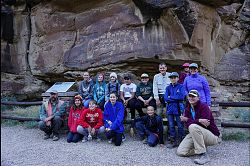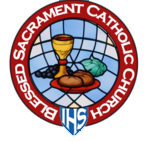Blessed Sacrament students present at Rock Art Symposium

(Courtesy Photo) Blessed Sacrament Middle School Archaeology Club members are shown with archaeologists Jody Patterson and Patricia Stavish.
SANDY — Blessed Sacrament School’s Archaeology Club is the steward of prehistoric Native American rock art at two sites along the western shore of Utah Lake. One of these is the Lake Mountain petroglyph panels, which may contain the oldest aboriginal rock art in the state.
The club’s stewardship efforts include photographing and studying the glyphs for meaning, assessing them for vandalism, identifying previously unknown petroglyph panels, filling out rock art site forms for the Intermountain Antiquities Computer System, and marking sites with mobile GPS devices so that Bureau of Land Management archaeologists can better preserve them.
The Archaeology Club has been active at Blessed Sacrament for more than a year. It was begun at the start of the 2017-18 school year by 5th-grade teacher John McHugh, a professional archaeologist and the club’s supervisor. It is open to students in the fifth through eighth grades.
Their activities, accomplishments and goals were presented at the annual Utah Rock Art Research Symposium, a prestigious conference attended by professional archaeologists, art historians, museum curators and rock art enthusiasts, which was held Oct. 5-8 in Bluff. Archaeology Club spokespersons Isabella Pickers (7th grade) and Alison Green (6th grade) gave a 25-minute presentation, titled “Preservation and Conservation of Utah Rock Art,” which was received with a standing ovation from the 200-plus conference-goers in attendance.
Utah Rock Art Research Association (URARA) President Steve Acerson presented the girls and the Blessed Sacrament Archaeology Club with a painting of the iconic Great Hunt rock art panel from Nine Mile Canyon.
The Blessed Sacrament students were the youngest presenters ever at the conference. They shared the podium with Ph.D.-level art historians and archaeologist, and presented with a confidence and passion that surpassed their years, McHugh said. “They did an outstanding job of articulating the accomplishments and goals of the Archaeology Club, and did it with the poise, grace, and humility that all Blessed Sacrament students are expected to display.”
The Blessed Sacrament Archaeology Club is the first youth-based program to take part in systemic preservation, conservation, and research of Utah rock art.
“The Blessed Sacrament Archaeology Club is URARA’s pilot program,” McHugh said. “The conservation and preservation practices that are shown to be successful with us may end up being utilized in educational outreach programs throughout the Southwest.”
As part of its activities, over the Sept. 28-30 weekend, the Archaeology Club took part in the excavation of an 800-year-old Fremont Indian pit house at picturesque Nine Mile Canyon located in south-central Utah.
The effort was coordinated through the BLM and Arizona State University Bureau of Tourism, and was supervised by Montgomery Archaeological Consultants of Moab, under the guidance of field archaeologists Jody Patterson and Patricia Stavish.
McHugh shares club supervision with Christine Green, who holds a degree in anthropology from the University of Utah. Last year the club met once a week and went on monthly field trips to various archaeological sites. This involved hands-on archaeological experience that included tasks such as cataloguing prehistoric artifacts at the museum at Fremont Indian State Park, screening for historic artifacts at Fort Douglas, and stewarding prehistoric Native American rock art at archaeological sites throughout Salt Lake and Utah counties.
The club goes by the handle “Shovel Bums,” which is the term for an entry-level archaeologist.
The goal of the Nine Mile Canyon excavation team was to learn more about an intriguing rectangular pithouse that dates to approximately 1200 AD. Although the work was grueling, the Archaeology Club students worked tirelessly and found numerous artifacts, including several knife-like tools that archaeologists refer to as a biface. Club members also found upwards of 80 shale or slate beads. The latter finds suggest that the pithouse functioned like a workshop that produced necklaces for the Fremont people and for trade with surrounding tribes.
When not excavating, the club members were led on tours to see the Fremont rock art panels all around the excavation site. The words of 6th-grader Jade Wilson summarize how everyone felt about their excavation experience: “I find it enjoyable and fascinating to learn things about the past. I wish to preserve rock art because it holds information about the past and holds stories about the native people who created it.”

